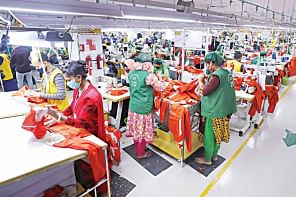Dhaka’s dying rivers: Pollution sources nearly doubled in 5 years

The rivers encircling Dhaka have been gasping for survival for decades, choked by pollution and encroachment.
Recent data, however, shows that the situation is deteriorating further -- and may be worse than previously imagined. A study conducted by the River and Delta Research Centre (RDRC) in January revealed that pollution sources around Dhaka's rivers have nearly doubled over the last five years, surging from 608 to 1,024.
The RDRC study, conducted in January using high-resolution satellite imagery and field surveys, exposes the breadth of pollutants choking the Buriganga, Turag, Shitalakhya, Balu, Tongi Canal, Karnatali, and Dhaleswari rivers. The findings revealed 102 industrial waste outlets discharging untreated pollutants into the waterways, along with 75 municipal sewerage lines and 216 small private sewerage outlets spewing domestic and industrial waste.
Additionally, the study highlighted 38 sluice gates and 62 service canals acting as conduits for contaminants, while 144 large dumping stations and 297 smaller dumping points worsened the situation with indiscriminate waste disposal. Dockyards, numbering 12, along with 46 industries and 36 kitchen markets, were also identified as major contributors to the pollution.
Dr Md Kamruzzaman, director general of the Department of Environment, said the department is yet to receive the final report.
"Once we have the full report, we will inform the ministry and take necessary actions," he said.
The DoE plans to finalise its response by mid-February, including the possibility of convening an inter-ministerial meeting.
However, critics remain skeptical.
"The last government spent Tk 1,000 crore on projects to protect Dhaka's rivers, but the doubling of pollution sources shows that enforcement has been abysmal," said Mohammad Azaz, chairman of the RDRC.
Urban planner Adil Mohammad Khan said, "The absence of a city-wide sewerage treatment system and the unchecked dumping of industrial waste are key contributors."
"Solid waste mismanagement and improper disposal by city dwellers exacerbate the problem," he added.
He criticised Dhaka's city corporations for lacking clear guidelines and failing to penalise violators.
THE NUMBERS TELL THE STORY
The Buriganga bears the brunt of pollution, with 506 sources identified as contributors. These include 12 industrial waste lines and 20 large municipal sewerage lines, alongside 167 small private sewerage outlets discharging untreated waste.
The river is further polluted by 30 sluice gates and 21 service canals, which channel contaminants directly into its waters. Additionally, 92 large dumping stations and 162 smaller dumping points exacerbate the crisis, with six dockyards, four industries, and 11 kitchen markets adding to the river's woes.
The Turag is burdened with 97 pollution sources. These include 13 industrial waste lines and 12 large sewerage lines, along with five small private sewerage outlets. The pollution is compounded by four sluice gates and seven service canals, while 15 large dumping stations and 27 smaller dumping points contribute to its degradation. Industrial pollution is significant, with seven industries and seven kitchen markets identified as major culprits.
In the Shitalakhya, 173 pollution sources were recorded, making it one of the most heavily polluted waterways. These include 42 industrial waste lines and 20 large sewerage lines, as well as 26 smaller sewerage outlets. The river is also affected by 18 service canals, 33 small dumping points, six dockyards, 21 industries, and seven kitchen markets, all of which contribute to its declining health.
The Balu suffers from 33 sources of contamination. These include three industrial waste lines, three large sewerage lines, and two small private sewerage outlets. Eight service canals and eight small dumping points further pollute the river, alongside six industries and three kitchen markets.
The Old Buriganga is affected by 89 sources, including seven large sewerage lines, four sluice gates, and one service canal. The river is further burdened by 28 large dumping stations and 46 small dumping points. Industrial activity contributes as well, with one industry and two kitchen markets adding to the river's contamination.
The Tongi Canal faces pollution from 79 sources. These include 29 industrial waste lines, 13 large sewerage lines, and 11 small sewerage outlets. Six service canals, four large dumping stations, and seven smaller dumping points exacerbate the problem, with five industries and four kitchen markets also playing a role in polluting this vital waterway.
The Karnatali river suffers from 26 pollution sources.
These include five small sewerage outlets and one service canal, as well as five large dumping stations and 14 smaller dumping points. One kitchen market further adds to the river's environmental stress.
Finally, the Dhaleswari has six identified sources of pollution. These include three industrial waste lines, two industries, and one kitchen market.
In 2019, the High Court declared rivers as legal entities, with the National River Protection Commission designated as their legal guardian. While the judgement marked a historic milestone, the ground reality remains dire. The NRPC has struggled to act decisively, hampered by limited enforcement power and institutional inertia.
Meanwhile, industrial development, has come at a devastating cost to the environment.
"Unchecked pollution is not only destroying rivers but also harming farmlands," said Khan, the urban planner.
"A balance between industrial development and environmental sustainability must be struck, but the government has consistently failed in this regard."

 For all latest news, follow The Daily Star's Google News channel.
For all latest news, follow The Daily Star's Google News channel. 



Comments